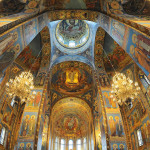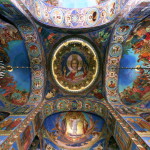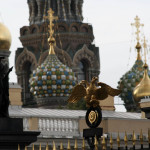The Church of the Saviour on Spilled Blood in St Petersburg
Address:
Saint Petersburg, naberezhnaya kanala Griboedova, 2, lit. B
Working time:
Monday - Tuesday: 10:00 - 17:00
Wednesday: Free
Thursday - Sunday: 10:00 - 17:00
None

In 1861, the Russian emperor Alexander the Second passed and imperial decree granting the serfs personal liberty and promising them portions of lands as their own.
Other measures followed the emancipation decree: greater academic freedom for Russia’s universities, local self-government, and a reorganization of the judicial system.
However, many young people were unwilling to wait for gradual reform. They founded revolutionary societies and tried to overthrow the government by striking directly at the throne. After escaping several assassination attempts, Alexander the Second was killed by a bomb in 1881.
The Church of the Saviour on Spilled Blood, also known as the Cathedral of the Resurrection of Christ, was built on the spot where Alexander the Second was fatally wounded as a memorial requiem, and also to draw a parallel between the deaths of Jesus of Nazareth and the Russian Tsar.
The section of railing on which he had leaned and the fragment of pavement stained with his blood are underneath an opulent hipped-roof marble and jasper baldachin. It’s the most notable place inside the commemorative cathedral and was erected over the spot where Alexander the Second was mortally wounded.
- Spilled Blood
Amazingly, the cost of this canopy was comparable to the cost of the rest of the cathedral.
Located between several classical architectural ensembles in the very heart of Saint Petersburg and visible from the famous Nevsky Prospect, the Church of the Saviour on Spilled Blood draws everyone’s glance with its brightly-colored domes and mosaics. Of the nine domes that crown it, five are especially ornate, and the church’s variegated decoration is influenced by Saint Basil’s Cathedral on Red Square in Moscow.
Approaching the church from Nevsky Prospect one can see the details of the Southern façade. A mosaic entitled Jesus in Glory decorates the pediment of the small sheltered shrine underneath a kokoshnik. In this mosaic Jesus sits on a throne flanked on either side by St. Alexander Nevsky and St. Nicholas. These particular Saints were chosen because their names are the same as the names of the Tsars during whose reign the Church on Spilled Blood was erected, as well as that of Alexander the Second, to whom it is dedicated.
Work on the cathedral continued for 24 years.
By August 31, 1907, the day of the cathedral’s consecration, 8.4 thousand square yards of its interior were covered with mosaics, more than any other church in the world. The precious and semi-precious stones used to decorate the church also contributed to its opulence.
Its multicoloured marble iconostasis was made in Genoa, Italy, and the best masters in Russia used Siberian gemstones to create its icon cases over a period of 12 years.
The Church of the Saviour on Spilled Blood is a superb example of Russian architecture and of the decorative and monumental art of the late 19th century. The style was executed by the architect Alfred Parland and has the features of the age of the Muscovite tsars of the 17th century, such as arcades, arches, kokoshniks, complex multi-profiled cornices, pilasters, horizontal articulations, and all kinds of insets.
The most outstanding examples of this style with typical Russian characteristics are the Church of Basil the Blessed in Moscow, as well as a number of churches in Yaroslavl and Rostov.
This unique monument, which had been created by the best Russian artists, architects and masters, found itself on the verge of destruction more than once during the Soviet era. Fortunately their resolutions never followed through. During an air raid of the WW2 a shell weighing 352 pound fell onto its roof but fortunately did not explode. It remained lodged inside the cupola until 1961 when it was finally removed and disarmed.
In 1968 the church of the Resurrection became an affiliate of St. Isaac’s museum and in 1974 the process of restoration began. It was reopened after 23 years of work in 1997.
The construction of such a huge and expensive Russian-style cathedral in St. Petersburg was not fortuitous. Many things changed when Alexander the Third came to power in Russia in 1881. His father’s violent death made him react by instituting stricter policies and harsher controls. He rejected the attempts that his father had made towards the democratization of Russia and in a manifesto issued on May 11, 1881, he proclaimed absolute power for himself.
«Russia for Russians» became the slogan of his reign. This “Russification” was evident in all of Russia’s state and public affairs, and in the art world as well.
Read more
- How to travel in Saint Petersburg without living your home
- Four of the ten best restaurants in the country are in St. Petersburg
- The first Holocaust museum in St. Petersburg
- A scientist from St. Petersburg created the biochronicle of Peter the Great.
- 10 interesting facts about Saint-Petersburg streets



